人教版新目标九年级英语Unit7单元集体备课教案
- 格式:doc
- 大小:135.50 KB
- 文档页数:13
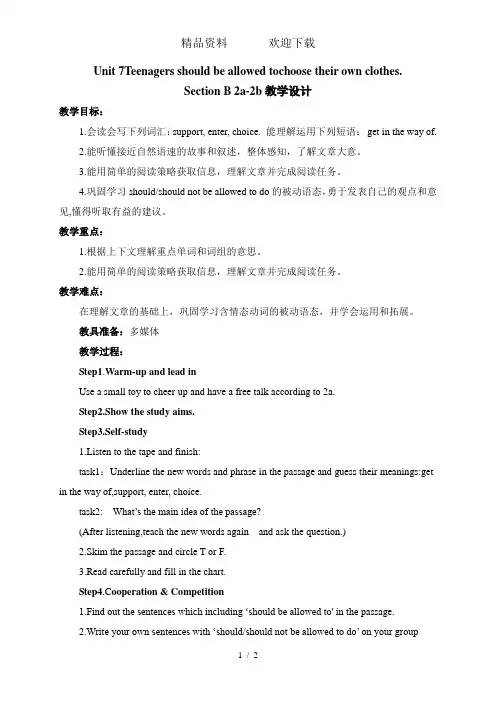
Unit 7Teenagers should be allowed tochoose their own clothes.Section B 2a-2b教学设计教学目标:1.会读会写下列词汇:support, enter, choice. 能理解运用下列短语:get in the way of.2.能听懂接近自然语速的故事和叙述,整体感知,了解文章大意。
3.能用简单的阅读策略获取信息,理解文章并完成阅读任务。
4.巩固学习should/should not be allowed to do的被动语态,勇于发表自己的观点和意见,懂得听取有益的建议。
教学重点:1.根据上下文理解重点单词和词组的意思。
2.能用简单的阅读策略获取信息,理解文章并完成阅读任务。
教学难点:在理解文章的基础上,巩固学习含情态动词的被动语态,并学会运用和拓展。
教具准备:多媒体教学过程:Step1.Warm-up and lead inUse a small toy to cheer up and have a free talk according to 2a.Step2.Show the study aims.Step3.Self-study1.Listen to the tape and finish:task1:Underline the new words and phrase in the passage and guess their meanings:get in the way of,support, enter, choice.(After listening,teach the new words again and ask the question.)2.Skim the passage and circle T or F.3.Read carefully and fill in the chart.Step4.C ooperation & Competition1.Find out the sentences which including ‘should be allowed to' in the passage.2.Write your own sentences with ‘should/should not be allowed to do’ on your grouppaper ,as many as you can,and have a competition with other groups. Step5.Summary and enjoy a songShould you be allowed to make all the decisions by yourselves?Step6.Practice1.Do a match.2.Choose the right answer.Step7.Homework1.Remember the new words and phrases in this lesson.2.Read the passage aloud after class.3.Finish the exercise book and prepare next period.Step8.Listen to the song “Be What You Wanna Be”.。
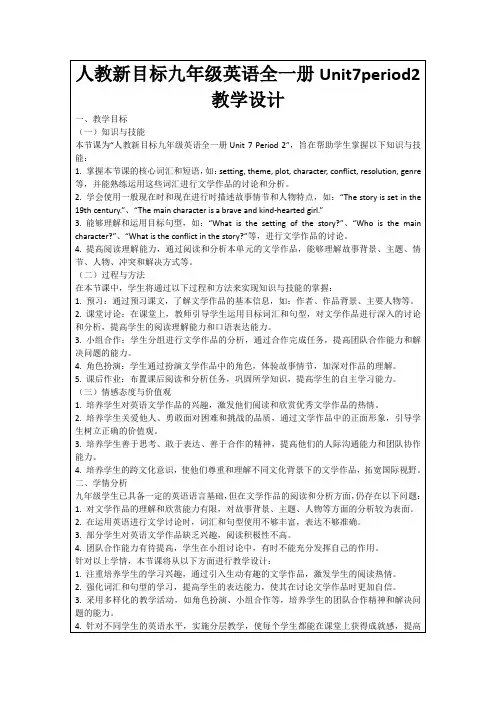
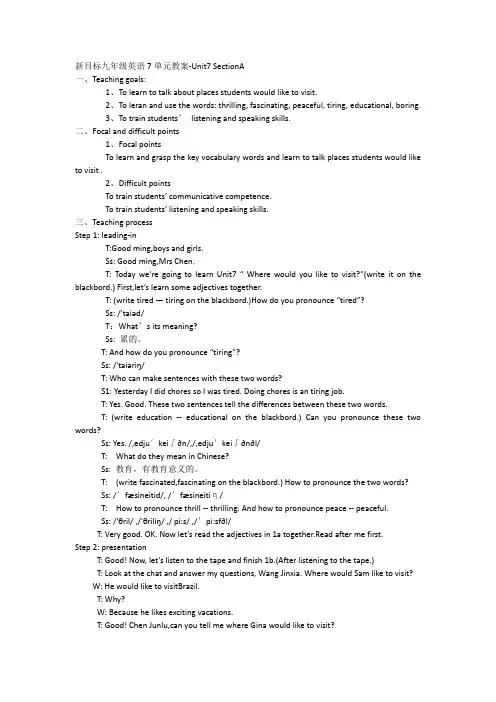
新目标九年级英语7单元教案-Unit7 SectionA一、Teaching goals:1、To learn to talk about places students would like to visit.2、To leran and use the words: thrilling, fascinating, peaceful, tiring, educational, boring.3、To train students’listening and speaking skills.二、Focal and difficult points1、Focal pointsTo learn and grasp the key vocabulary words and learn to talk places students would like to visit .2、Difficult pointsTo train students’ communicative compete nce.To train students’ listening and speaking skills.三、Teaching processStep 1: leading-inT:Goodming,boys and girls.Ss: Good ming,Mrs Chen.T: Today we’re going to learn Unit7 “ Where would you like to visit?”(write it on the blackbord.) First,let’s learn some adjectives together.T: (write tired —tiring on the blackbord.)How do you pronounce “tired”?Ss: /'taiəd/T:What’s its meaning?Ss: 累的。
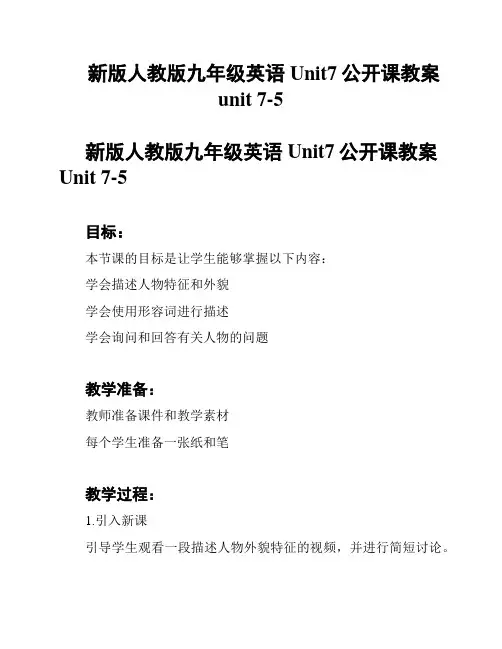
新版人教版九年级英语Unit7公开课教案unit 7-5新版人教版九年级英语Unit7公开课教案Unit 7-5目标:本节课的目标是让学生能够掌握以下内容:学会描述人物特征和外貌学会使用形容词进行描述学会询问和回答有关人物的问题教学准备:教师准备课件和教学素材每个学生准备一张纸和笔教学过程:1.引入新课引导学生观看一段描述人物外貌特征的视频,并进行简短讨论。
提问学生是否知道如何用形容词来描述人物的外貌,激发学生兴趣。
提出本课的主题和目标,预告将要学习的内容。
2.学习单词和短语教师呈现人物外貌特征相关的单词和短语。
例如:tall。
short。
long hair。
etc。
通过图片和动画帮助学生理解和记忆新词汇。
3.练习描述人物分发纸和笔给每个学生,让他们画出一个自己心目中的人物形象,并在旁边使用所学的形容词描述。
学生互相交换纸张,并尝试通过描述猜测对方所画的人物。
4.模仿对话教师示范一段询问和回答有关人物的问题的对话。
学生们分组,自行编写对话并进行模仿演练。
5.小结反思教师向学生总结本节课所学的内容,并强调重点。
提供额外练习材料,并告知学生下次课前需要复习的内容。
作业:要求学生写一篇短文,描述自己或一个虚构的角色的外貌特征。
要求使用至少五个形容词进行描述。
参考资料:人教版九年级英语教材相关网络资源和图片注意事项:教师要根据学生的实际情况和课堂进展合理安排教学时间。
鼓励学生积极参与互动和讨论,提高口语表达能力。
教师要引导学生进行自主学习和思考,促进他们的主动性和创造力。
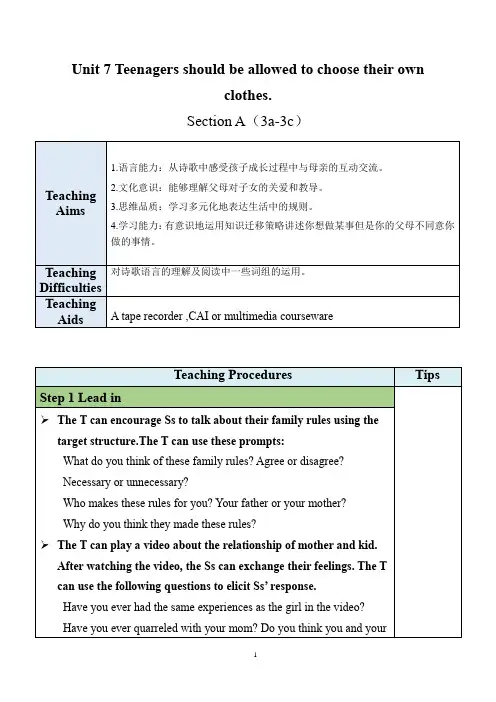
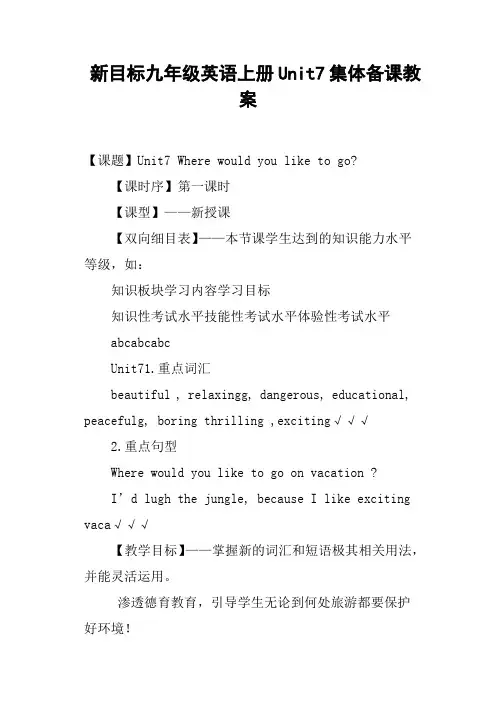
新目标九年级英语上册Unit7集体备课教案【课题】Unit7 Where would you like to go?【课时序】第一课时【课型】——新授课【双向细目表】——本节课学生达到的知识能力水平等级,如:知识板块学习内容学习目标知识性考试水平技能性考试水平体验性考试水平abcabcabcUnit71.重点词汇beautiful , relaxingg, dangerous, educational, peacefulg, boring thrilling ,exciting√√√2.重点句型Where would you like to go on vacation ?I’d lugh the jungle, because I like exciting vaca√√√【教学目标】——掌握新的词汇和短语极其相关用法,并能灵活运用。
渗透德育教育,引导学生无论到何处旅游都要保护好环境!【教学重难点】——使学生能口头、笔头熟练地运用新学的词汇、短语和句型来描述一个地方【教学方法】——mind map,3Ps(presentaaduction)teaching, task-based learning teaching【学习方法】——individual work, pair work, group work(discuss, make a conversa)【教学准备】——multi-media , tader, students’ b【教学过程】教学内容及教师活动学生活动设计意图I Lead-w the maworld .T: What kind of countries do you knowap?T: What kind ddo you know?T: What do you think abouuntries and cities?II Presenta(1)T: Where would you like to visit? I would like to visit U.S.A Becaubeautiful.T: Where would you like to visit?T: Why would you like to visit U.S.A.(2)Showures and lactice:Ⅲ Listening(1) Show two pictures of Florida Beach and Amazon Jungle and lbest to describ(2)Where would Sam and Gina like to go on vacation?Listen and filla(3) Listen and read aa(4) Lll the listening materialⅣ Survake a survey: let Ss work in group:Where would you like to visit?Why would you like to visit it?Who would you like to go with?How would you like to go there?What would you like to d?Report:…would like to visit…Becau…Ⅴ SummaryWhat do we learn today?They talk about couaw. S: China, the U.S.A, the U.K, Canada, Australian, France, Ger many, Mexico…They talk abouaw.S: Beijing, New York, London, Tdney, Paris… They talk about some ad: thrilling, fascinating, peaceful, tiring, educational, exotic, boring fun,S: I would like to visit….S: Becau…..A: What would you like to visit?B: I’d like to visit…A: Why would you like to v?B: Because…best to describe them by using some adjs thaave learnt.Let Ss listen and fillaAaad aaRetell the listening material.Make a survey and do aabouaum uwords and通过世界地图让学生复习以前曾经学过的国家和地名,并教授相关的新单词, 本环节对学生的自学作出了检测,同时也复习了旧的知识,达到温故而知新的目的。
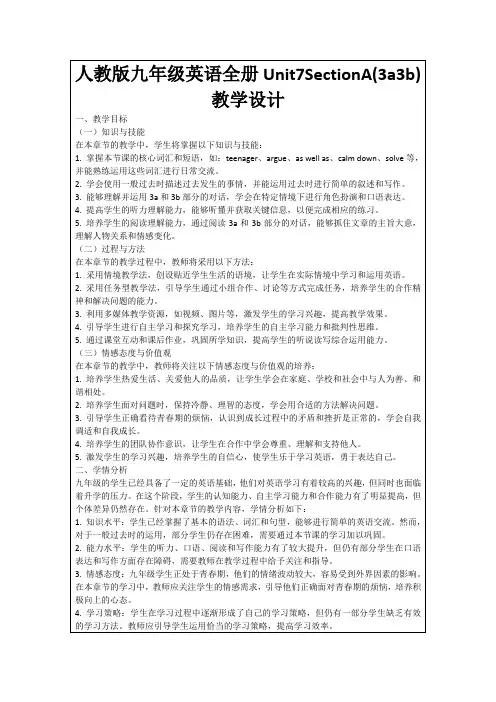

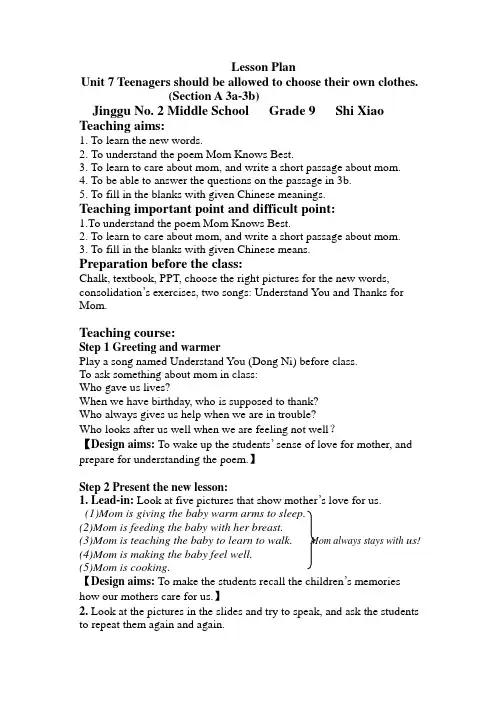
Lesson PlanUnit 7 Teenagers should be allowed to choose their own clothes.(Section A 3a-3b)Jinggu No. 2 Middle School Grade 9 Shi Xiao Teaching aims:1. To learn the new words.2. To understand the poem Mom Knows Best.3. To learn to care about mom, and write a short passage about mom.4. To be able to answer the questions on the passage in 3b.5. To fill in the blanks with given Chinese meanings.Teaching important point and difficult point:1.To understand the poem Mom Knows Best.2. To learn to care about mom, and write a short passage about mom.3. To fill in the blanks with given Chinese means.Preparation before the class:Chalk, textbook, PPT, choose the right pictures for the new words, consolidation’s exercises, two songs: Understand You and Thanks for Mom.Teaching course:Step 1 Greeting and warmerPlay a song named Understand You (Dong Ni) before class.To ask something about mom in class:Who gave us lives?When we have birthday, who is supposed to thank?Who always gives us help when we are in trouble?Who looks after us well when we are feeling not well?【Design aims: To wake up the students’ sense of love for mother, and prepare for understanding the poem.】Step 2 Present the new lesson:1. Lead-in: Look at five pictures that show mother’s love for us.(1)Mom is giving the baby warm arms to sleep.(2)Mom is feeding the baby with her breast.(3)Mom is teaching the baby to learn to walk. Mom always stays with us!(4)Mom is making the baby feel well.(5)Mom is cooking.【Design aims: To make the students recall the children’s memories how our mothers care for us.】2. Look at the pictures in the slides and try to speak, and ask the students to repeat them again and again.tiny, cry, field, hug, regret, lift, teen, awful, poem, badly, talk back 【Design aims: To make sure the students master the relative vocabularies for the following reading.】3. Look at the pictures in the slides and try to express your agreement and disagreement properly. (Look at the pictures and try to make some dialogues according to your own situations.) The answers are vary. (1)Mom says: Teenagers should not be allowed to eat too muchice-cream.I say: I’m sorry to hear that. The ice-cream is really delicious.(2)Mom says: Teenagers should not be allowed to go out with their friends every night.I say: I think we can go out if we can make sure our safety.(3)Mom says: Teenagers should not be allowed to play computer games day and night.I say: I agree with you. It makes the teenagers not sleep well and make them hate learning. (I disagree with you. If we go and play on weekends, we aren’t able to influence our schoolwork. And so on)(4)Mom says: Teenagers should not be allowed to watch scary movies alone.I say: Oh, no. We aren’t babies at all. We are enough bravely to watch them. (Yes, it’s too scary. Maybe it will make us have dreams. And so on.)(5)Mom says: Teenagers should not be allowed to smoke.I say: I don’t think so. When we smoke, it will make us look very cool. (It will make us be like adults. And so on.)【Design aims: To review the Grammar Focus: should be +v-pp, and to show the students, most of the things that parents think is right. In this way, the students will understand the poem Mom Knows Best better.】4. To present the learning aims to the students:(1)To understand the poem Mom Knows Best.(2)To learn to care about mom, and write a short passage about mom.(3)To be able to answer the questions on the passage in 3b.(4) To fill in the blanks with given Chinese means.[Design aims: To make the students know what they should do and how to do it well.]5. 3a Reading tips:1) Read aloud the poem, and underline the sentence patterns, circle the sentences using the passive voice of modal verbs and find out the useful phrases in the poem. Ask a few students to read aloud their answers in class.Important point sentence patterns:I regret talking back, not listen to mom.regret doing sth 对某事感到懊悔,遗憾(已做)(1)I regret taking the medicine. (take)(2)I regret meeting you in my live. (meet)regret to do sth 做某事很遗憾、很抱歉(没做)(1)We regret to tell you that your car isn’t mended. (tell)(2) I regret to tell you that your money isn’t brought. (tell)[Design aims: To make the students be sure how to read a passage and how to accumulate more vocabularies in everyday learning activities. In this way, they can understand more reading materials in the future. Another thing is to learn how to care about our mom. And to master the important sentence patterns and make sentences with the sentence patterns. 】2) Listen to the tape and read aloud the poem again, and discuss with your partners what the title means, and answer the questions in 3b.The title is about a mother always knows what is best for a child, even though the child may disagree with her.(1) What did the mom do when the writer was a small child?1) sang to him and stayed by his side when he cried;(2)gave him food and warm arms to sleep in when he was tired and hungry; 3) keep him safe when he was running through the field; 4)hugged him and lifted him up when he felt.(2)Why do you think the writer talked back to his mom when he was seven and nine years old?He felt that he should be allowed to watch scary movies and eatice-cream.(3)How did the writer feel when he was a teenager and his mom said “Please be back by ten”?He was very upset (angry).(4)After reading the whole poem, how do you think the writer feels about his mom?He loves his mom and feels that his mom knows best.【Design aims: To make the students understand the general idea on the poem, and learn to know about mom more.】Step 3 Summary and consolidation: Play the song GanXie Mom (Thanks for Mom.) and to finish the exercises. Then discuss with the students how to care about our mom.Write down the phrases according to the given Chinese meanings, and pay attention to use the right forms.1. You shouldn’t talk back with your mother.(回嘴,顶嘴)2. I always have scary movies at night. (做噩梦,噩梦连连)3. We mustn’t watch scary movies when we are alone. (恐怖电影)4. He often goes out with his best friend on weekends. (和某人外出)5. When I think back to these old things, I regret talking back with my mother. (回想起)6.“Please come back \be back at 10:30 on time.”says my mom. (回来)【Design aims: To master the important phrases in the poem and learnto use them in the specific situations and learn how to care about our mom in everyday lives. 】Step 4 Homework1. Read aloud the poem again and again, then try to recite it.2.Writing practice: Mom, I’d Like to Tell Y ou【Design aims: To recite the poem and understand mom’s love for mein our daily lives. To be able to tell mom what you think in English. 】Blackboard Design:Mom Knows BestI Momlittle bab y→crying all night: sang to me and stayed with me tired and hungry: gave me food and warm armstwo→running through the field: made sure I was safe felt and hurt: gave me a hug and lifted me up seven→coughing badly: no ice-cream for menine→watching scary movies: would give me awful dreams teen→going out with friends: Please be back by ten (seventeen)We should:understand, love, care about, worry about, respect, help, listen to, patient,get on well with mother for ever.。
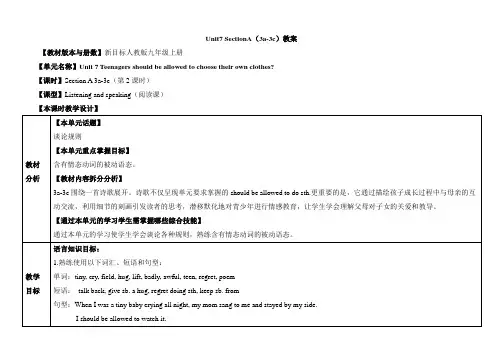
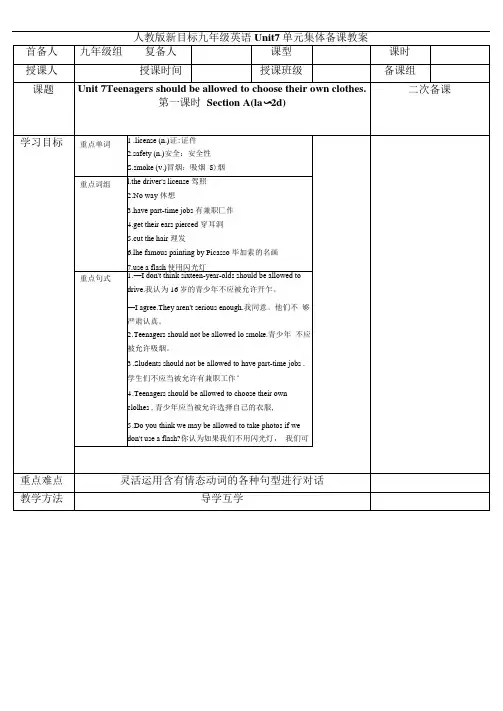
人教版新目标九年级英语Unit7单元集体备课教案Step 1情景导入参考案例每个青少年在生活中都会碰到允许或者不允许做某事,例如在商场购物时,我们应该允许选择自己的衣服,而作为父母却不允许我们选择自己的衣服,你们有这样的经历吗?你们是赞同还是不赞同呢,请大家说出自己的观点。
(4分钟)Teacher: Could you tell me what students should be allowed to do or shouldn't beallowed lo do?Students: __________________________________©Students should be allowed to have part-time jobs.②Students shouldn't be allowed to get their ears pierced.环节说明:通过课前的一个师生问答互动,让学生对自己感兴趣的话题产生共呜,能训劫学生学习的积极性,何时be 疝owcdtod。
的应用,为学习新课埋下了伏笔。
教学过程Step 2完成教材la-lc的任务【操作案例】1.要求学生解开课本P49,迅速阅读la部分的内容。
然后自己判断赞同还是不赞同la的内容° (1分钟)2.检查答案,先要求全班一起给出答案并检查讨论。
然后要求小组就should be allowed to do sth.的用法进行讨论,并通过以下问题对青少年应该做什么或者不允许做什么进行反馈,与学生互动。
(3分钟)参考案例Teacher:! don't think students should be allowed to go to Net Bar.Students:! agree.3.要求学生听第一遍录音,并完成课本上1b的听力任务。
(1分钟)4.要求学生听第二遍录音,并逐句进行跟读。
人教版新目标九年级英语Unit7单元教案Unit 7Teenagers should be allowed to choose their own clothes.Section A (1a-2d)学习目标1.重点单词:license,safety,smoke,parttime,pierce,earring,flash2.重点短语:sixteenyearolds3.重点句式:I don't think sixteenyearolds should be allowed to drive. I'm worried about your safety.Anna wants to get her ears pierced.I'm really excited about seeing the famous paintings by Picasso.Do you think we may be allowed to take photos if we don't use a flash?学习重点1.重点短语和句型2.含有情态动词的被动语态学习难点1.重点短语和句型2.含有情态动词的被动语态自主学习一、预习课本P49-50新单词并背诵,完成下面的汉译英。
1.证件________ 2.安全________3.吸烟________ 4.兼职的________5.刺破________ 6.耳环________7.闪光灯________二、认真预习1a-2d找出下列句型。
1.我认为16岁的青少年不应该被允许开车。
__________________________________________________________ ______________2.我担心你的安全。
__________________________________________________________ ______________3.安娜想打耳孔。
Unit 7 Where would you like to visit?The First PeriodⅠ.Teaching Aims and DemandsKnowledge Objects(1)Key Vocabularytiring, educational, fascinating, thrilling, peaceful, exotic, trek, jungle, take it easy, explore, historic, site(2)Target LanguageWhere would you like to go on vacation?I’d like to trek through the jungle, because I like exciting vacations.2.Ability Objects(1)Train students to talk about places they would like to visit with the target language.(2)Train students to describe vacations with different adjectives.(3)Train students’ listening skill.3.Moral Object,It′s more interesting to go on vacating somewhere instead of staying at home.Ⅱ.Teaching Key Points1.Key Vocabularytiring, educational, fascinating, thrilling, peaceful, exotic, trek, jungle, take it easy, explore, historic, site2.Terget LanguageTalk about different places with the target language.Ⅲ.Teaching Difficult Points1.Describe vacations with different adjectives.2.Talk about different places with the target language.Ⅳ.Teaching Methods1.Teaching by illumination2.Teaching by doing chain drills3.Teaching by pairworkⅤ.Teaching Aids1.A tape recorder2.Some pictures of different places with famous viewsⅥ.Teaching ProceduresStep ⅠRevision1.Revise the language points in Unit 6.Provides some questions, What kind of music do you like/love/prefer? What kind of clothes/writers/movies/…do you like/love/prefer?Then ask two pairs to make model conversations to the class to make sure they answer, I like/love/prefer music that…I prefer writers who…Next ask students to practise in pairs.Walk around the classroom listening to them, correct some errors they may make and be sure they are answering with sentences with relative clauses.2.Revise the words and expressions in Unit 6 by dictating the following:lyric, remind of, entertainment, exhibition, gallary, on display, energy, suggest, photograph, suit Step Ⅱ1aAt first introduce the key vocabulary.Point to the words and teach the children to read them several times till they can pronounce the words fluently and correctly.After that, try to let students explain the adjectives and make up sentences with them.For example, exciting, do like this:Let’s try to explain some new adjectives in our own words and make up some sentences now.See exciting first.Who can explain it in your own words in English?What does exciting mean?Help the children to explain it.Exciting means not boring, or means hard to be quiet.Who can make up a sentence with it?Give an example sentence with it, please.Ask several ones to say their sentences to the class.For example,Surfing makes us exciting.The boy is very exciting when he is watching a football match.Tell students to look at the posters in the picture and compare them.We can see three posters.Tell me what you can see in each one.Then discuss the three posters with students.For Poster One, help students to say, It is a beach.A man with sunglasses is sleeping, etc.Do the same to the other two posters.Read the words on each poster to students and then let them read together several times.Ask some ones to tell the Chinese meanings of the words to see if they can understand them.Do some explanation if necessary.Call the students’ attention to the chart.Point to vacation 1,2 and 3 in the chart.Say, Let’s choose the adjectives from the box for the three vacations.The adjectives you choose should correspond with the posters.Now let’s use Vacation 1 as a sample.Which adjectives should we choose? Who can tell me?Then ask several students to tell the class the words they’ve chosen.Write down their answers on the blackboard like this:Vacation 1 Take it easy on a Florida beach!Adjectives: relaxing, peaceful, boringWho has got some other adjectives to describe it? Some other adjectives you know, but not in the box?Ask some to say more besides the ones in the box, such as quiet, lazy.Write them on the blackboard, too.Please fill in the chart with the adjectives now.Note to match the posters.Get them to fill in the answers by themselves.As they work, move around the room checking their progress and answering questions they may have.Check the answers.Step Ⅲ1bWe’ll listen to three students talking about where they would like to go on vacation and why.See the sample answers in the chart.Write your answers like that while you hear.Look at the three posters in Activity la and do this part.Each one of the three students, Sam, Gina and Lydia, wants to go to one of the three places.Play the tape for the first time, and tell the students not to write in a hurry, just try to catch the main idea of the dialogue.Then play the recording again.Ask them to write their answers this time.Check the answers.Step Ⅳ1cPresentate this dialogue, showing some pictures of the places with great interest all over the world and say like this:I’d like to travel to France.I’d love to visit Paris, because I like relaxing vacations.Where would you like to go on vacation, Sam?Ask one student to answer the question.After that let him or her ask another student.Set off a chain drill like this:T: I’d love to visit Paris, because I like relaxing vacations.Where would you like to go on vacation, S1?S1:I’d like to climb Mount Emei, because I like dangerous vacations.Where would you like to go on vacation, S2?S s :I prefer to travel to the USA, because I like exotic vacations.Where would you like to go on vacation, S3?S3…After a team finished get the children to make their own conversations in pairs.Ask two students to read the example in the speech bubbles in Activity la.Tell them to talk about the posters with their partners this time.As students work together, move around the classroom, offering language support as needed.Ask some pairs to say their conversations to the class.Step ⅤSummaryIn this class, we’ve learned some adjectives that are used to describe vacations and some other words.We have also learned the target language—Where would you like to go on vacation? I’d like to trek through the jungle because I like exciting vacations.Step ⅥHomework1.Try to remember the new key vocabulary.2.Write out three similar conversations to the example in the picture in Activity 1a.Step ⅦThe Second PeriodⅠ.Teaching Aims and Demands1.Knowledge Objects(1)Key Vocabularyfall, Niagara Falls(2)Target LanguageWhere would you like to visit?I’d like/hope to visit/see…I’d like/love places where…2.Ability Objects(1)Train students’ listening skill.(2)Train students’ communicative competence.3.Moral ObjectIt can make you know more about the world to travel much.Ⅱ.Teaching Key Points1.New words fall, Niagara Falls2.Listening practice with target language3.Make communications with target languageⅢ.Teaching Difficult Points1.Train students’ listening practice with target language.2.Help students to make communications with target language.Ⅳ.Teaching Methods1.Listening 2.Pairwork 3.ExplanationⅤ.Teaching Aids1.A tape recorder2.Some pictures of Hawaii, Mexico and Niagara FallsⅥ.Teaching ProceduresStep ⅠRevision(1)Revise the target language by asking question, Where would you like to go on vacation? Get several students to give different answers.Then ask them to work in pairs to practise with:Where would you like to go on vacation?I’d like/love to…because I like…vacations.(2)Check homework by asking several ones to read their conversations.(3)Check homework by dictating the following words:tiring, educational, fascinating, thrilling, relaxing, dangerous, exotic, trek.jungle, take it easy, explore, historicAfter dictating, hove students check in pairs.Make a survey by asking them to put up hands to see how many have written out all the words correctly.Step Ⅱ2aRead the instructions to the students.Look at the four sentences in the box.They are from a conversation, but they are not in the right order.We will listen to a conversation talking about going on a vacation.We can see the number in from of the fourth sentence.It’s a sample answerPlease write the right numbers before the first three sentences in the blanks.Then play the tape.Students only listen this time.Try to catch the main idea of the conversation.Next play the tape again.Students listen and write the numbers in the blanks.Check the answers.Step Ⅲ2bThis activity provides listening practice using the target language, too.Read the instructions to students, and make sure that they know what to do.Look at the first column, "Place".Someone doesn’t like going to these places.Why? Choose the reason for each place from the second column.Write the letters of the reasons in the blanks before the places/Let’s read the contents in the chart first.Get them to read the places and reasons several times.Then say, we’ll listen to the same recording again.Listen andmatch each place with a reason for not going there.Play the recording again.Ask students to fill in their answers.Check the answersStep Ⅳ2cRead the instructions to the students.Tell them to use the information in Activities 2a and 2b to role play conversations.(Holding a picture of Hawaii).I hope to visit Hawaii some day.Get a student to answer, So do I.I like places where the weather is always warm.Showing a picture of Mexico, ask two students to make up similar conversations.Note to use the information in Activities 2a and 2b.Do the same with the third place Niagara Falls.Say, Now please role play the conversations in pairs, using the information in Activities 2a and 2b.Each pair makes one at least.As the students work, move around the room checking progress of the pairs and offering help as needed.Ask one or two move pairs to say their conversations to the class.Step 5 Grammar FocusPresentate the conversation below by saying to the students and writing it on the blackboard: Where would you like to visit?I’d like to go somewhere relaxing.Draw a line under the word relaxing.Then ask the children the same questions and tell them to answer in their own words.For example,I’d like to go somewhere interesting.I’d like to go somewhere exotic.After asking several children to give answers with different adjectives, get them to practice in pairs.Each pair makes two conversations.Next ask several pairs to share their conversations with the class.Then say, the adjectives usually come before the nouns, such as, an educational vacation, a tiring trip.But in the sentences which are using the word something or somewhere, the adjective should be put after the pronouns.For example:I’d like to go somewhere fascinating.I’d love to eat something delicious.After that, presentate another pair of sentences.Say to the students and write down on the blackboard:Where would you like to visit?I hope to go to France some day.Explain sentences with some day in English orally, like this,I hope to go to France some day.This sentence means I hope to go to France some day, but I’m not sure I will.Maybe I will go there in the future and maybe I won’t.The sentences with some day are often used to express that.Then have the children make up more sentences.Step ⅥSummaryIn this class, we’ve done some listening practice with target language.We have also practiced our oral English in pairs.And we’ve discussed something on grammar.Step ⅦHomework1.Write out two pairs of sentences like this:Where would you like to visit?I’d like to go somewhere relaxing.Where would you like to visit?I hope to go to France some day.2.Practice the target language orally with the classmates.Step ⅧThe Third PeriodⅠ.Teaching Aims and Demands1.Knowledge Objects(1)Key Vocabularytouristy, spotlight" Singapore, beautiful, heavy, private, downtown, get around, Pack, light(2)Target LanguageWhere would you like to go, Kathy?I’d like to visit Kunming.2.Ability Objects(1)Train students’ reading skill.(2)Train students’ skill of communication.3.Moral ObjectShare your experience on travelling in a city with your classmates and tell them what they should bring if they decide to visit it.Ⅱ.Teaching Key Points1.Guide students to read the passage in Activity 3a.2.The new vocabularyⅢ.Teaching Difficult PointHelp students to talk to their partners about the cities they know.Ⅳ.Teaching Methods1.Teaching by illumination.2.Teaching by asking questions.Ⅴ.Teaching ProceduresStep ⅠRevision1.Revise the target language they learned last class by asking Where would you like to go on vacation? Get several children to answer I’d like to…because…2.Check the homework by asking some children to read the conversations they wrote to the class.Step Ⅱ3aAt first introduce the key vocabulary words.Teach students to read the vocabulary several times until they can read them out easily and correctly.Read the passage quickly and try to answer the questions on the blackboard.Write these questions on the blackboard:1.What doesn’t Singapore have?2.What does Singapore have?3.Is Singapore also a wonderful place for shopping?4.What don’t you plan on doing in singapore? why?5.What is easiest to do in Singapore?6.What is suggested to bring if you decide to go there? Why?A few minutes later(maybe two or three minutes), ask different students to answer the questions.Play the video tape of Singapore for students or show them some pictures.Next, read the instructions to students.Say, What things do you like about visiting Singapore and what things don’t you like? Read the passage again.Circle the things you like about visiting Singapore and underline the things you don’t like.Get them to finish the activity on their own.Check the answers.Step Ⅲ3bRead the instructions to students.Make sure that they know what to do.Ask two students to read the sample conversation on the left in Activity 3b,Note to correct any pronunciation errors to make sure the students are providing a good model for the rest of the class.Ask another pair to model a conversation with the first group of words on the right, the words in the first line.Listen to them carefully with the whole class to see if they can put the words in the proper places.Then let the whole class practice in pairs.Each pair should make up four conversations with the information on the right.Walk around the classroom as the students are working.Listen to some pairs and see if they have met any problems.Offer some help as needed.After all the students have finished practicing, ask some more pairs to share theirconversations with their classmates.Step ⅣPart 4Read the instructions to the children.Make sure that they understand it.Say, First think of a city you know, everyone.I think of Dalian.What about you?Ask several ones to tell the names of the cities they’ve thought of.Then say, Please write down the name of the city you’ve thought of on the line above city name in the chart.After that, show some photos of Dalian to the students around the room.Then continue saying, Dalian is a very beautiful city with wonderful beaches.It has very long coast.It also has quite a few big and nice parks.Some are near the sea and some are not.I like the big museum of different kinds of sea animals, too.What about you? What do you like about the cities you’ve written in your book?Ask two or three to say something about their cities.Then say, Now please fill in the left box with the things you like about the city.I’ll write mine on the blackboard, you can use it as a sample.Write the sample on the blackboard, and students write out theirs.Walk around the classroom and direct them to write.After all of them have finished, go on with the third step.Now talk to your partner about the things you don’t like.After they finish talking, go on saying something I don’t like about Dalian to them.For example, The things in Dalian are too expensive.They are for the rich.And there are too many cars running on the streets.It’s very hard for people to cross a street.Can you say something you don’t like about your cities?Ask some to say something on that to the class.Then tell them to fill in the box for things you don’t like.Let them talk to their partners about it.Step ⅥSummaryIn this class, we’ve learned something about Singapore, and we’ve talked about some other places all over the world.We’ve done a lot of listening, speaking, reading and writing practice using the target language.Step ⅦHomework1.Write a short passage on the city you talked about in class.2.Try to remember the new words on page 54.Step ⅧThe Fourth PeriodⅠ.Teaching Aims and Demands1.Knowledge Objects(1)Key Vocabularycustomer, save money, pool, culture, dream vacation, travel agency(2)Target LanguageWhere would you like to go?I’d like to go somewhere warm.2.Ability Objects(1)Train students’ listening ability.(2)Train students to use the target language in oral English properly.3.Moral ObjectTo role play the conversations you’ve heard is a very good way to improve your oral English.Ⅱ.Teaching Key PointTrain students’ listening skill by listening to the conversations with the target language.Ⅲ.Teaching Difficult PointHelp students to role play the conversations.Ⅳ.Teaching Methods1.Brainstorm2.Listening method3.PairworkⅤ.Teaching AidA tape recorderⅥ.Teaching ProceduresStep ⅠRevision1.Revise the passage about Singapore by asking two or three students to read it to the class.Make sure that they pronounce each word correctly.Then let students read it aloud once by themselves.2.Check the short compositions they have written at home.First let several ones read theirs to the class.Second, get them to work in pairs to check the compositions.At last, collect all students’ compositions.Go over them carefully after class.Step ⅡPart 1This activity reviews the target language and introduces new vocabulary.Read the instructions to students.Explain brainstorm like this:Brainstorm a list of things means you should write down all the ideas that come into your minds.Now brainstorm a list of things that are important to you when you go on vacation.Write them down in your exercise books.You should not worry if an idea is silly or if a word is spelled wrong.You can even write a word in their first language for the moment.Ask them to have a look at the two model phrases the book provides before they begin.Move around the room offering language support as needed.After about three minutes, tell them to stop writing and thinking.Let’s review the ideas you’ve thought of together.We will correct spelling and find the correct English words for any words you don’t know.Then ask some children to read their lists to the class.Write any new words orphrases they have used on the blackboard.Ask them to discuss the lists in groups of four.Each one reads his or her own list to the other three.Then they discuss the words or phrases together.If there is something that they are not sure, tell them to show me by putting up their hands.Move around the room and solve the problems they may have.Help students find the correct English words to express their ideas.Step Ⅲ2aRead the instructions to students.Tell them to guess the meaning of travel agency first.Then explain it like this:If you plan to have a trip or vacation, you can go to a travel agency.A travel agency is an office that can help you make travel plans.Also they help you get plane tickets and hotel reservations.Then presentate whale watch and amusement park to the class like below.A whale watch tour means you stay in a ship and go out to the oceaning during the time of year when the whales are migrating, then you can see them travelling.Amusement park means a place like disneyland.You can do lots of rides and play lots of games there.Write the two phrases on the blackboard.Look at the three pictures in Activity 2a now.We know Jeff has a summer job at a travel agency.We will hear him talking on the phone with three different people.Can you see the small box in the corner of each picture? Listen to the conversations and number the pictures.Write a proper number in each box to show the right order of the pictures.Then play the tape for the first time.Tell them only to listen.Play the tape a second time.As they listen to the tape this time, have the students number the pictures.Check the answers.Step Ⅳ2bRead the instructions to the children.Tell them to look at the chart.Then read the headings Customer, Wants, Doesn’t want and pointout the blanks under each one.And let them see the sample answer under Wants in the chart.Ask them to read it together.Say, Then first customer wants to go somewhere warm.I’ll play the recording again.Please write down the things the three customers want and don’t want in this chart as you listen to the recording.The play the recording again.Students fill in the blanks with the words they hear.Pause the tape several times to give students time to fill out the chart.Correct the answers.Step Ⅴ2cThis activity provides guided oral practice using the target language.Read the instructions to the children.Say, In this activity, you are asked to role play Jeff’s conversation with the information in the chart in Activity 2b.Ask a pair of students to read the sample conversation to the class.Offer more phrases,…to go to a small town,…to go by ship,…to go to a place which is too crowded, …to travel by plane,…to go to anywhere too far, ect.Write them on the blackboard.Then ask students to practice in pairs.Move around the room checking the progress of the pairs and offering help as needed.Ask one or two pairs to say their conversations to the class.Correct any mistakes they may have made.Step ⅥSummarySay, In this class, we’ve done lots of listening practice on target language, and we’ve also written and spoken some.Step ⅦHomework1.Write out the phrases you have brainstormed in Activity 1.2.Write down the conversation in Activity 2c.StepThe Fifth PeriodⅠ.Teaching Aims and Demands1.Knowledge Objects(1)Key Vocabularyprovide, firm, offer, spot, Confucius, stele, forestThe Forest of Steles(2)Reading practice using the target language(3)Writing practice using the target language2.Ability Objects(1)Train students’ reading skill.(2)Train students’ writing skill.(3)Train students’ listening and speaking skills.3.Moral ObjectAre you planning to take a trip this summer?Write an e-mail to a travel agency in English to get some information on vacations.Ⅱ.Teaching Key Points1.The new vocabulary.2.Read an e-mail.3.Write an e-mail.Ⅲ.Teaching Difficult PointWrite an e-mail.Ⅳ.Teaching Methods1.Scanning the e-mail to find out the answers2.Writing3.GroupworkⅤ.Teaching ProceduresStep ⅠRevision1.Revise the conversation in Activity 2c on page 55 by making a conversation with one student like this,T: Where would you like to go?S s: I’d like to go somewhere relaxing.T: What else can you tell me?S: I don’t want to go to big noisy cities.After that, ask them to practice in pairs.Ask several pairs to share their conversations with the whole class.2.Check their homework.Step Ⅱ3aThis activity provides reading practice using the target language.At first, introduce the key vocabulary words.Teach students to read the words and expressions several times.Then ask several to read to the class.Make sure that they can read the words fluently and correctly.Read the instructions to students. Make sure that each student knows what they will have to do.Go over the statements about the e-mail message with the whole class.Make sure that they can understand all the six sentences in the box.And tell them to put the six statements in their minds while they scan the e-mail below.Say, Boys and girls, please scan the e-mail in Activity 3a now.Try to get the main idea of the letter and find out the answers to the statements.Ask them to scan the letter individually, and write T, F or DK before each statement.After they’ve all finished scanning, check the answers with the whole class.Elicit why the false sentences are false at the same time.After checking the answers, tell the children to read the passage more carefully and prepare to answer the questions on the blackboard.After they’ve all finished reading, get some students to answer these questions.Encourage them to ask questions on what they don’t understand about the e-mail.Ask one student to read the letter to the class.Help him or her with the pronunciation.Then let all the students read the passage several times.Step Ⅲ3bRead the instructions to students.Ask: Who can explain the instructions in your own language?Choose two or three among those who have put up their hands to explain the instructions in English.They may say like this, Suppose I work for Ace Travel Agency and I have received the letter from S.T.Zhang.Then it is my duty to reply the e-mail and I have to tell where they should go on vacation.After they all know what to do, get them to begin writing.Move around the classroom as they write, offering help if necessary.Remember whose passage is excellent and prepare to ask them to read theirs to the class.After they’ve all finished writing, ask the students who have written very good passages to read theirs to the class.Let them work in pairs to correct the mistakes in the passage they’ve written.Tell them that they have to rewrite the letters after class and bring them to school tomorrow.Step ⅣPart 4Read the instructions to students.Say something about the three places in the chart.Showing some pictures of these places to the students, say like this, Qufu is a small city in Shandong Province.It is famous for Confucius.It was Confucius’ hometown.He was born there.The Great Wall is the pride of the Chinese people.It is very long and it is hard to believe that it was built over two thousand years ago.The Forest of Steles in Xi’an is a great place for people who are interested in writing Chinese with brushes.What do you think of the three places?Look at the chart in Activity 4.We can see the sample answer in the box about Qufu in the column of you.Continue saying, Now please fill in the boxes about The Great Wall and The Forest of Steles in Xi’an on your own.You can use the words above the chart or any other word.Tell them to write out the three students’ names in the proper places in the chart.Then get them to survey the three students.Let them work in groups of four.Ask a pair of students to read the model conversation in Activity 4 before they begin their own ones.At last, have several groups report the results to the class.Then ask the class where they would prefer to go together.Step ⅤSummaryIn this class, we’ve read an e-mail to a travel agency and we’ve also written an e-mail.And we’ve done some reading, writing, listening and speaking practice using the target language through group work.Step ⅥHomework1.Rewrite the e-mail which you wrote in class.2.Try to remember the new words and expressions on page 56.Step ⅧThe Sixth PeriodⅠ.Teaching Aims and Demands1.Knowledge Objects(1)Key Vocabularysurf, arctic(2)Use the following words properlyhope, pack, save, provide, cook(3)Write an article using the target language.2.Ability Objects(1)Train students to use the verbs hope, pack, save, provide and cook well.(2)Train students’ writing skill.3.Moral ObjectDo you want to travel abroad? Englishwill be very useful for you then.It is spoken all over the world.Ⅱ.Teaching Key Points1.Help students have a self check on the key words and target language.2.Practice using the verbs.hope, pack, save, provide, cook3.Write an article.Ⅲ.Teaching Difficult Points1.Use the verbs hope, pack, save, provide and cook.2.Write the article.Ⅳ.Teaching Methods1.Teaching by making sentences.2.Teaching by writing.Ⅴ.Teaching AidThe pictures of the four placesⅥ.Teaching ProceduresStep ⅠRevision1.Check the homework by asking students to show their e-mails.Choose several to read theirs to the class.Then let them work in pairs and read their own letters to the partners.At last, collect all the letters.。